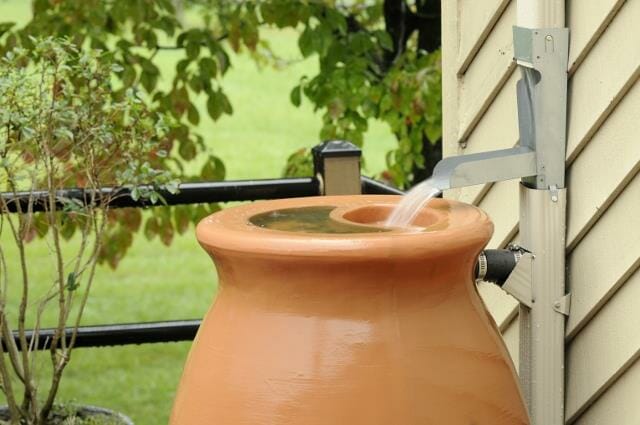
Using Rain Barrels and Other June Gardening Tips
Using Rain Barrels and Other June Gardening Tips
Charlie Nardozzi, Horticulturist and
Leonard Perry, UVM Extension Horticulturist
 Using rain barrels to collect and conserve water, pruning rose suckers, and preventing tomato blossom end rot are some of the gardening activities for this month.
Using rain barrels to collect and conserve water, pruning rose suckers, and preventing tomato blossom end rot are some of the gardening activities for this month.
If you’re not familiar with rain barrels, these are typically 55-gallon drums or similar large containers used to collect rainwater, typically off roofs through modified downspouts. They continue to increase in popularity, with some you can buy painted or even of plastic to resemble large clay urns. Water from these is fine for flowers and shrubs, but may be questionable for edible crops. Since the water comes off roofs, it may contain petrochemical compounds from asphalt shingles or treated wood shingles, air pollution fallout, or waste from birds and squirrels.
If you want to use rain barrel water in the vegetable garden, avoid getting it on the foliage or fruit, but water the soil instead. Some collect a “first flush” of 5 to 10 gallons, which contains much of any possible waste, and use it for non-edible plants. If using in the garden, rinse any fruit or produce with potable water prior to consumption. Keep your rain barrel cleaned periodically, and at the end of the season in particular.
On grafted roses, any growth that originates below the graft union — called suckers — will not be what you bought the rose for. The foliage may look different and the flowers will be inferior, often a different color, to flowers on shoots growing above the graft. Clip off any sucker growth because it saps energy from the plant. These shoots are usually quite vigorous.
Blossom end rot shows up as dark, sunken spots on the blossom end of tomatoes, peppers, and squash. It’s caused by a calcium imbalance in the plant — the soil may have adequate calcium, but the plant isn’t able to take up enough to supply the rapidly developing fruit. To minimize the problem, keep soil evenly moist, apply a layer of mulch to conserve moisture, don’t over fertilize (avoid high-nitrogen fertilizer), and avoid damaging plant roots while cultivating.
“Indeterminate” or vining tomato plants produce many suckers — new shoots that start where a branch connects with the main trunk. Removing suckers will decrease the number of fruits produced, but the remaining tomatoes will be larger and will ripen sooner.
If you’re using a string trimmer to trim around trees, be careful not to damage the tree bark. Repeatedly striking tree bark with weed whacker strings opens the tree to infection, and may over time kill the tree by cutting through the tender bark. Technically, this is known as “girdling”. Mulch around trees so you don’t have to trim close to the trunk, or place tree guards on the trunks. Just make sure you don’t pile mulch up around the trunks creating a “volcano” of mulch. This can smother the trunk, harbor insects, and possibly kill the tree over time.
If you are looking for a new peony, check out ‘The Mackinac Grand’. This won the 2013 gold medal from the American Peony Society, and was named 2014 Peony of the Year. Released in 1992, this early to midseason herbaceous peony has warm red, semi-double flowers with yellow floral parts (stamens) in the center. It has strong stems, so shouldn’t need staking.
Aspirin water has been found to promote healthy growth and enable plants to stand up to diseases, stresses, and some insects. Dissolve one or two regular aspirin tablets per gallon of water, then spray plants. One time is all that’s needed.
6/1/14
Charlie Nardozzi is a nationally known horticulturist, author, gardening consultant, and garden coach (CharlieNardozzi.com). Distribution of this release is made possible by New England Grows– a conference providing education for industry professionals and support for Extension’s outreach efforts in horticulture.
Receive your complimentary Relocation guide and magazine

